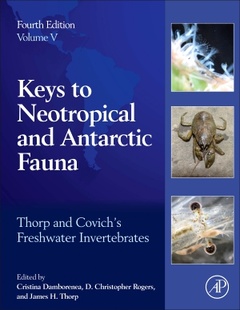Description
Thorp and Covich's Freshwater Invertebrates (4th Ed.)
Volume 5: Keys to Neotropical and Antarctic Fauna
Coordinators: Damborenea Cristina, Rogers D. Christopher, Thorp James H.
Language: English
Keywords
ecology; taxonomy; taxa; keys; aquatic; phyla; South America; Central America; Antarctic; Antarctica; Amazon River; biodiversity; water management
1046 p. · 21.4x27.6 cm · Hardback
Description
/li>Contents
/li>Readership
/li>Biography
/li>Comment
/li>
Thorp and Covich's Freshwater Invertebrates, Volume 5: Keys to Neotropical and Antarctic Fauna, Fourth Edition, covers inland water invertebrates of the world. It began with Ecology and General Biology, Volume One (Thorp and Rogers, editors, 2015) and was followed by three volumes emphasizing taxonomic keys to general invertebrates of the Nearctic (2016), neotropical hexapods (2018), and general invertebrates of the Palearctic (2019). All volumes are designed for multiple uses and levels of expertise by professionals in universities, government agencies, private companies, and graduate and undergraduate students.
1. Introduction
Part I 2. Protozoa 3. Phylum Porifera 4. Phylum Cnidaria 5. Phylum Platyhelminthes 6. Phylum Nemertea 7. Phylum Gastrotricha 8. Phylum Rotifera 9. Phylum Nematoda 10. Phylum Nematomorpha 11. Phylum Mollusca 12. Phylum Annelida 13. Phylum Ectoprocta (Bryozoa) 14. Phylum Entoprocta 15. Phylum Tardigrada
Part II 16. Phylum Arthropoda: Introduction and Arachnida 17. Arthropoda: Introduction to Crustacea and the Class Hexapoda 18. Class Cirripedia 19. Class Branchiopoda 20. Class Ostracoda 21. Class Copepoda 22. Class Branchiura 23. Phylum Arthropoda: Crustacea: Malacostraca
Professional scientists and technicians in ecology, environmental science, freshwater biology, limnology, invertebrate zoology and related fields, private companies, government agencies, and NGOs
groups of aquatic invertebrates as well as aquatic invasive species in South America. Cristina Damborenea created and leads a research group in free living Platyhelminthes of the Neotropical region. She has numerous peer-reviewed publications focused on the taxonomy and ecology of invertebrates, invasive mollusks, scientific field guides, and studies of the dissemination of scientific knowledge.
Dr. D. Christopher Rogers is a research zoologist at the University of Kansas with the Kansas Biological Survey and is affiliated with the Biodiversity Institute, with numerous research projects all over the world. He received his PhD degree from the University of New England in Armidale, NSW, Australia. Christopher specializes in freshwater and terrestrial crustaceans (particularly Branchiopoda and Malacostraca) and the invertebrate fauna of seasonally astatic wetlands on a global scale. He has more than 150 peer-reviewed publications in crustacean
taxonomy and invertebrate ecology, as well as published popular and scientific field guides and identification manuals to freshwater invertebrates. Christopher is an Associate Editor for the Journal of Crustacean Biology and a founding member of the Southwest Association of Freshwater Invertebrate Taxonomists. He has been involved in aquatic invertebrate conservation efforts all over the world.
Dr. James H. Thorp is a professor and senior scientist at the University of Kansas (Lawrence, KS, United States). Prior to 2001, he was a distinguished professor and dean at Clarkson University, department chair and professor a
- Includes zoogeographic coverage of the entire Neotropics, from central Mexico and the Caribbean Islands, to the tip of South America
- Provides identification keys for aquatic invertebrates to genus or species level for many groups, with keys progressing from higher to lower taxonomic levels
- Contains terminology and morphology, materials preparation and preservation, and references




